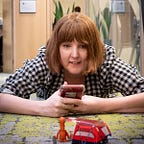Service Design Training with Experience Haus — Week 4
Documenting my experiences on this 12 week course
I recently left my role as Associate Director at Social Finance via voluntary redundancy. As part of this change I decided that I would look to use my skills in a service design role.
We have just completed Week 4. You’ll see the curriculum for the course below:
I think I’m a little blurry in this week, I think I’ve not been feeling the best which has played a part, but I found our session on Monday relatively frustrating. This isn’t fair, as I’m on a training programme and just because I feel like I could move on doesn’t mean everyone does. I just felt a little stuck with the pace and frustrated that we weren’t moving forward with prioritising our areas for research on our project.
I think, in retrospect, that what I experienced was a vacuum where some more detailed training on methods should have been.
In the session instead we talked a bit through this article by Erika Hall, particularly the framework.
Don’t get me wrong, this is a bloody good framework. Our course leader Daniel also pulled out this great quote:
“I see design research as a design activity, more than a research activity. What matters most is learning what you need to know in order to make the best possible design decisions within existing constraints. It doesn’t necessarily matter if you uncover anything new, or whether you document what you learn in a specific format. It does matter that you are intentional, conscientious, and ethical at every step.”
It’s also clear that people in the cohort have at least some understanding of methods, so maybe taking a higher level on this was justified, but I can’t help but feel like we could have had a richer discussion if we had focused on more detail on the content of the slides for the session.
I’ve gone back and read through it all and there’s soooo much rich stuff in here, but I think not having a grounding in a range of techniques (at least in theory) is contributing to some people feeling a little confused, as we move into research planning we need to have a cohort who feel more confident in understanding and identifying which approaches to take and when. It’s a balance at least.
Honestly I think Monday was probably a blip, and these things happen, Wednesday’s session was much better (IMHO) because it was more action oriented again.
In this session the cohort started outlining research goals and questions. I also thought the session was really nicely facilitated as we split into smaller groups and worked together, then we came back together and removed duplicates or discussed terminology so that everything was clear. We then used some simple labels to highlight which areas were for primary research, secondary research and where we might need to talk again to the client.
We now have a fair amount of homework to bring this into a research plan, again working in smaller groups which is useful. I’m really keen to just crack on with research because currently we have a lot of questions but no information that I can use to find signals about what needs to be done, so I’m keen to get going.
As a reminder our ‘exam question’ is how could Green Tomato start to deliver a national fruit gifting service? We are feeling our way around this as a concept but also seeking to understand what makes Green Tomato great, what sets them apart, and what is important to them. Part of this is around understanding the root causes of wanting to do fruit delivery — which appears (at the moment) to be driven by a desire for profitability, driven by the desire for a lovely new electric delivery vehicle. My feeling is that if profitability is the aim, then there must be other ways (and maybe more effective ways) to do this.
We learned that Nisha and her husband who run Green Tomato have run successful pilots of providing fruit to schools (as part of a healthy tuck shop scheme) they are also planning to bring a grocery service to a local hospital and have recently signed a contract with a local BCorp to provide fruit for their workers.
I also think that there might be a great opportunity for Green Tomato to support Local Authorities in their commissioning of initiatives around public health — I wonder what opportunities there are to build relationships with commissioners to help support that work (and get funding?)
So I’m thinking about what small things we could try.
Would the Local Authority support something like a leaflet with every purchase which helps to inform people about nutrition? How might you measure the impact of Green Tomato on social exclusion? Are there local adult social care initiatives who Green Tomato could partner with?
There is so much to do in this space and it’s really exciting the number of routes we could go down.
Looking forward to next week!
